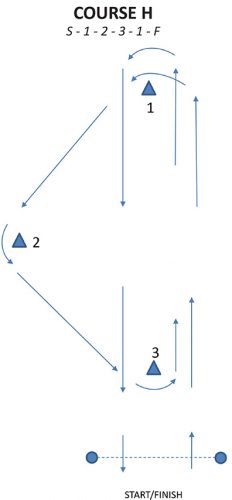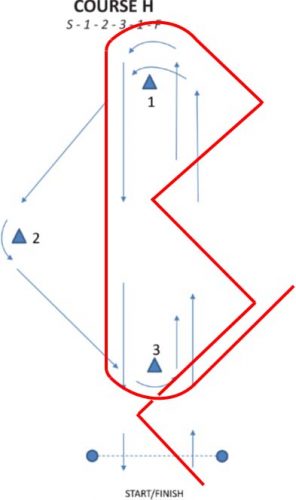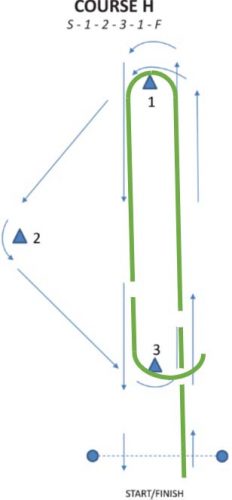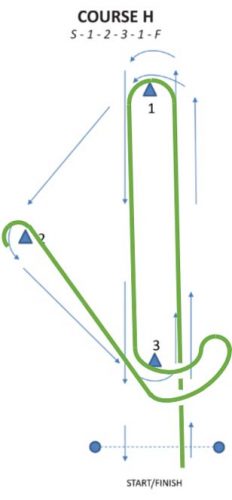Often, we focus our rules discussions only on Part 2 of the rules – “When Boats Meet.” This winter, I plan to explore the rules of Part 3 – “Conduct of a Race.” They may appear to only matter to the Race Committee, but they have significant importance to the racing sailor too.
– Steve Harris, US Sailing National Race Officer
Rule 28 - Sailing the Race
28.1
“A boat shall start, sail the course, and then finish . While doing so, she may leave on either side a mark that does not begin, bound or end the leg she is sailing. After finishing she need not cross the finishing line completely.”
28.2
“A boat may correct any errors in sailing the course, provided she has not crossed the finishing line to finish.”
This seems simple enough, right?
Well, not exactly. Before we dig into the text of the rule, in order to fully understand this rule (and the many nuances to it) we also need a good understanding of the definitions of start, finish, and sail the course. The definition of rule provided in the Racing Rules of Sailing is pretty broad – “The rules in this book, including the Definitions, Race Signals, Introduction, preambles and the rules of relevant appendices, but not titles…” (Yes – the definition of rule defines that the definitions are also rules. Don’t spend too much brain power on that one – it just is what it is.)
Let’s start with those definitions and then break this rule down too…
Start
This one, we discussed in detail in the post on Rule 29 – Recalls.
If you need to review, CLICK HERE.
Finish
- takes a penalty under rule 44.2,
- corrects an error in sailing the course made at the line, or;
- continues to sail the course.
As with seemingly everything else in the racing rules, there are a few interesting nuances here. Numbers 2 & 3 under this definition particularly apply to how Rule 28 works. Essentially, to finish, one crosses the finish line from the course side . But this definition also allows for correcting errors in sailing the course… more on that as we look closer at the rule.
Sail the Course
- passes each mark of the course for the race on the required side and in the correct order,
- touches each mark designated in the sailing instructions to be a rounding mark, and
- passes between the marks of a gate from the direction of the course from the previous mark.
This is commonly called the “string rule” and I’ll refer to it that way in our discussion of Rule 29.
We’ll Start at the Beginning and Break Down Rule 28.1
“A boat shall start, sail the course, and then finish…”
Makes sense, right?
The course will be published in the Sailing Instructions and should be clear as to course configuration, mark descriptions, and on which side marks are to be left. The RRS requires this under J2.1:
(4) the course(s) to be sailed, or a list of marks from which the course will be selected and, if relevant, how courses will be signalled;
(5) descriptions of marks, including starting and finishing marks, stating the order in which marks are to be passed and the side on which each is to be left and identifying all rounding marks (see rule 28.2);
A typical course, that we use at BLYC may be illustrated like this…

“…While doing so, she may leave on either side a mark that does not begin, bound or end the leg she is sailing…”
This part may be confusing…
Reworded and simplified, if there is a mark that isn’t part of the leg on which you’re sailing, ignore it.
In our “Course C” illustrated above, we see this. On the first windward leg (from the start to mark 1), Mark 2 does not “begin, bound, or end the leg” you’re sailing on. You can leave it on either side… For that matter, you can run it over (Please don’t run over our marks though. They’re not indestructible and they’re expensive to replace.)
“…After finishing she need not cross the finishing line completely.”
Simply put, you only need to “break the plane” of the finishing line in order to finish. If we look back at the definition of finish, it tells us “A boat finishes when, after starting, any part of her hull crosses the finishing line from the course side.“
But, why then, don’t you have to cross completely? There are situations where doing so may not be desirable. For example, the finish line may be very near to an obstruction – a headland, a commercial shipping channel, etc. It may be that there is a strong current pushing you down-course. You don’t want to risk drifting back into the mark and touching it after finishing. It may be better to break the plane, drift back below the line and bear off. I am aware of one situation in particular where racing on the Niagara River in Buffalo, the finish line is sometimes downstream. Going any farther north than necessary is not advisable – there is a rather precipitous drop ahead! (and a sailboat is not a barrel)
Sometimes, we make mistakes…. 28.2
“A boat may correct any errors in sailing the course, provided she has not crossed the finishing line to finish.”
One great thing about the Racing Rules of Sailing is that that it provides many opportunities to correct errors.
Let’s look at another one of our standard BLYC courses.

Let’s assume, for the sake of explanation, that you are racing on Course H, but you initially miss that signal from the Race Committee. You assume that you’re racing on Course C (as above). Instead of sailing from Mark 1 to Mark 2 as instructed, you “skip” Mark 2, sail directly to Mark 3 and round it. You have broken RRS 28.1

But, RRS 28.2 allows you to correct that error. In order to do, let’s go back and look at the definition of Sail the Course – AKA the “String Rule.”
Sail the Course
- passes each mark of the course for the race on the required side and in the correct order,
- touches each mark designated in the sailing instructions to be a rounding mark, and
- passes between the marks of a gate from the direction of the course from the previous mark.
Imagine that, as you sail the course, you are trailing a “string” behind you. This string lies in the water and shows the track your boat has taken.
You have omitted Mark 2 in our example and that string, when pulled taut would not “pass” Mark 2 “on the required side” (1) nor would it “touch” that mark (2).

But, you can correct that error! Simply “unwind” the string.
But… think about how you need to do that. You can’t simply sail over to Mark 2, leave it on the required side, and sail to Mark 3. If you did that, you wouldn’t have rounded the marks in the correct order.

However, if you sail back around Mark 3 – in the opposite direction – you can “unwind” the string and then sail to Mark 2, round it properly, and continue to race – rounding Mark 3 again, of course.

If you now pull that “string” taut, you’ve rounded the marks, in the correct order, leaving them on the required side, and have met the requirements of Rule 28 and the definition of Sail the Course.
You sailed a lot of extra distance, but you have properly corrected the error.
This is just but one example…
There are all kinds of “what-ifs” that we could discuss, but we’d likely get very far off “in the weeds.” Simply put – if you miss a mark of the course, THINK about how you have to “unwind” the string to comply with 28.2. There are a number of World Sailing Cases that deal with Rule 28. I’ll include those at the end of this post for those who may be interested in digging deeper.
But… then there’s this somewhat confusing exception in the definition of Finish to consider too…
“… However, she has not finished if after crossing the finishing line she
takes a penalty under rule 44.2,
corrects an error in sailing the course made at the line, or;
continues to sail the course.”
This has a definite (and significant) impact on Rule 28. That said, for the sake of brevity, I think it may better be a discussion for a later post.
